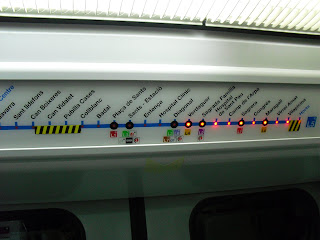4. Website: "We conclude with the democratic dictatorship."
My take: "Let us put an end to the democratic dictatorship!"
The website and I differ in our interpretation of "acabem". Spanish speakers, think of the verb "acabar." The nosotros command would be either "acabemos" or "acabémonos" if you wanted to be reflexive. I'm not sure whether "acabem" is only the present tense "we" form or can also be used as the "we" command in Catalan.
I'm not sure when this was written, so it could have been written during the Franco regime (approx. 1939-1975), and that would make the website's take correct. But I suspect that it's been written in modern times as the author's protest of the dictatorial ways of a current or past democratic government. Or, it could be a Catalunya-specific protest of the fact that the central government in Madrid is not allowing Catalunya enough autonomy. Searching "spain democratic dictatorship" and "democratic dictatorship catalunya", I stumbled upon this blog post which I concede is fiercely partisan in favor of Catalunya but nevertheless encapsulates well the ideological conflict between the region of Catalunya and the Madrid central government. This 2005 article from the Financial Times is more grounded, giving specific examples of some of the things Madrid and Barcelona are trying to work through. I had no idea Spain had so many autonomous provinces, it's actually a main regional breakdown of the country (like states in the US) - check out the Wikipedia article Autonomous communities of Spain for a better idea of how they work.
5. "In Barcelona, 1 in 3 deaths in traffic accidents was on foot! Warning! We are all pedestrians!"
Yikes! I've never thought about where such a percentage should lie, but that strikes me as pretty high. Part of it may be because of Barcelona's interesting intersections - most street corners are actually sliced off, to create parking spaces and open up the blocks. Frequently, the city's 4-bin recycling system is placed here as well. This is wonderful for traffic flow, because those who are turning can clear the street they are turning away from, while still allowing pedestrians to pass, because they can sit in the space where the corner would have been and the crosswalks are slightly indented compared to the intersection itself. But, it's not fun for pedestrians, because walking along a street means weaving in and out to access each crosswalk instead of just walking in a straight line. Impatience may cause one to not want to utilize the crosswalk every time, and just walk straight, through a wider swath of the intersection. I suspect this may cause at least some of the fatalities, because with bins and cars parked everywhere, it can be harder to see an oncoming car; plus you are also more exposed to those that are turning.
2. "I am a beach, not a huge ashtray, ok?"
1. "Here next to [this sign] there are trash bins, please use them."
Pretty self-explanatory. The beach is fed up with everyone's cigarette butts, and so it tells the locals to quit it already. The beach where I took this was Platja Passeig Maritim, which is right next to two hugely famous clubs in Barcelona, Opium Mar and Shoko. Thus, the sign may lose a little of its efficacy because a lot of tourists frequent that beach, but as I'm discovering more and more in Barcelona, if a printed statement is in only one language, it's almost always in Catalan. The only time I see printed Spanish-only statements are if its part of a national campaign, like advertising a TV show that is available all over Spain or a campaign against plastic bags; local or regionally-oriented statements are in Catalan.
3. "Closure of the corridor linking L3 and L5 at the Diagonal station...Due to construction of the interchange, starting on May 27 the passageway linking L3 and L5 at Diagonal station will be closed. The link between the two Metro lines will be down the street. The route to follow will be signaled in the street. When entering the Metro again, it will be necessary to revalidate the ticket; without doing so, the ticket will behave as if you haven't already taken a trip (and thus will charge you for another instead of giving you a free transfer). Remember, you can make the link between L3 and L5 at Sants Station. See the network map to choose other alternative routes."
We did this transfer and I don't remember needing to get the ticket revalidated, but I didn't check the ticket the second time, perhaps we were actually double billed. The metro system in Barcelona seems to work pretty well; the lines look like spaghetti in how they cover the city, but it actually does a very good job of covering all the areas. Plus, they have a few other cool features, including a button you have to push/handle you have to pull to get the door to open (which saves energy for the air-conditioned train), and a display that shows the line you are on with a flashing light under the station you're heading to next.

No comments:
Post a Comment